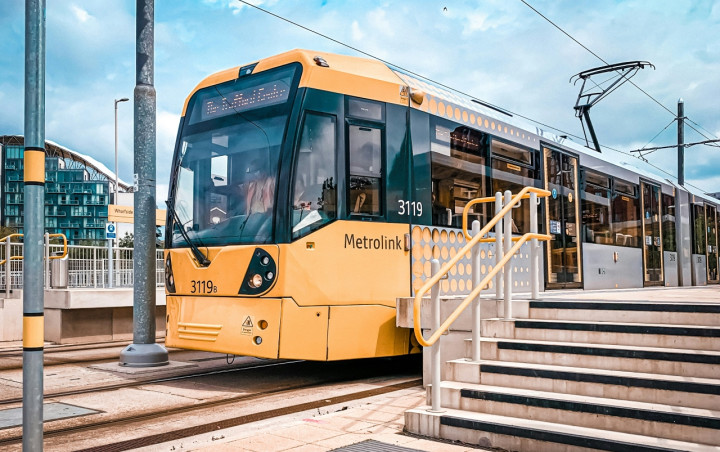Promet in infrastruktura
Naj bo javni prevoz najboljši način prevoza.

Medtem ko so vsi sektorji med letoma 1990 in 2022 znatno zmanjšali emisije CO², so emisije, povezane s prevozom, narasle za osupljivih 123%. Spremeniti moramo svoj pristop in javni prevoz preobraziti v izbrani način prevoza za posameznike in delodajalce. Zaradi geografske strukture Slovenije, jo tvorijo tudi številna majhna naselja na gričevnatem ali gorskem terenu, je težko povsod zagotoviti privlačen, pogost in hiter javni prevoz. Zasebni prevoz, predvsem z avtomobilom, bo zato še vedno ohranil pomembno vlogo v celotnih vzorcih mobilnosti.
Vendar pa moramo podpreti bolj trajnostne izbire, da olajšamo obremenitev našega cestnega sistema in okolja zaradi individualnega in tovornega prevoza ter bolje upoštevati zunanje vplive, ki vključujejo tudi onesnaževanje s hrupom, prometne zastoje in vpliv na zdravje.
Volt Slovenija predlaga:
Povečana dostopnost javnega prevoza
Ustvariti zanesljivo železniško in avtobusno infrastrukturo s ciljem preusmeritve polovice obstoječih 900.000 dnevnih voznikov v javni prevoz.
Zagotoviti zadostne kapacitete za parkirišča z možnostjo nadaljnjega prevoza (P+R) z infrastrukturo za polnjenje električnih vozil v bližini avtocest/železniških prog za nemoteno povezljivost z avtobusi in vlakih na srednje in dolge razdalje.
Odpraviti zakonske zahteve glede minimalnega števila parkirnih mest pri novih gradnjah.
Zanesljiv usklajen vozni red javnega prevoza
Uvesti usklajene vozne rede javnega prevoza po vsej državi, kjer bo vsaj en vlak (avtobus) ob isti minuti vsako (drugo) uro, po vzoru Švice, Nizozemske, Češke, Madžarske in Slovaške.
Zagotoviti najmanj en vlak na uro (vedno ob isti minuti) na vseh glavnih progah. Regionalne linije se lahko zmanjšajo na en vlak na dve uri med kosilom, zvečer, ob koncih tedna in praznikih.
Ponuditi najmanj en hitri vlak (intercity/pendolino) na uro med Ljubljano, Celjem in Mariborom, vsakih 30 minut v konicah, ter najmanj en vlak vsakih 30 minut na primestnih linijah okoli Ljubljane (Logatca, Kamnika, Litije, Grosuplja, Kranja).
Uskladiti čase prihodov in odhodov z kratkimi prehodi med vlaki ter lokalnimi in regionalnimi avtobusnimi linijami na glavnih prestopnih točkah (Ljubljana, Zidani Most, Celje, Pragersko, Maribor, Jesenice, Pivka, Divača, Sežana, Trebnje, Sevnica).
Uvesti usklajene medkrajevne avtobusne linije po avtocestah na povezavah, kjer železniško omrežje ne ponuja konkurenčnih časov potovanja (Postojna - Ajdovščina - Nova Gorica - Gorizia, Maribor - Murska Sobota) ter dodati te povezave v mednarodno bazo podatkov voznih redov vlakov za lažji spletni nakup vozovnic preko aplikacij skupaj z vlakom.
Mreža hitrih železnic in dodatne kapacitete
Investirati v železniško infrastrukturo za skrajšanje potovalnih časov in zagotavljanje usklajenega integriranega voznega reda, da bodo povezave Ljubljana-Celje, Celje-Maribor, Ljubljana-Jesenice in Ljubljana-Postojna izvedene v manj kot 45 minutah.
Ustvariti dvotirno progo, kjer je to potrebno (enotirna proga je lahko zadostna), da se omogoči en vlak na vsakih 15 minut v prometnih konicah na linijah Ljubljana-Kamnik, Ljubljana-Grosuplje in Ljubljana-Kranj, ki služijo tudi letališču.
Izboljšana čezmejna povezljivost
Izboljšati čezmejno potovanje z zagotavljanjem najmanj enega vlaka na vsakih 2 uri za naslednje povezave:
Ljubljana - Kranj - Jesenice - Villach (Beljak) (naprej proti Salzburgu in Münchnu)
Ljubljana - Zidani Most - Krško - Zagreb (naprej proti Slavonskemu Brodu, Beogradu)
Ljubljana - Celje - Maribor - Leibnitz - Graz (Gradec) (naprej proti Dunaju)
Ljubljana - Postojna - Villa Opicina (Opčine) - Trst Letališče (naprej proti Vidmu, Benetkam)
Izboljšati regionalno čezmejno potovanje z zagotavljanjem najmanj enega vlaka na vsakih 2 uri za naslednje povezave:
Maribor – Dravograd – Bleiburg (Pliberk)
Sežana – Villa Opicina – Trst Centrale
Postojna – Ilirska Bistrica – Rijeka
Metlika – Karlovac
Rogaška Slatina – Krapina
Ormož – Čakovec – Mursko Središće – Lendava
Hodoš – Zalaegerszeg
Jesenice – Villach (Beljak) (1 vlak na uro)
Maribor – Spielfeld-Strass (1 vlak na uro)
Nova Gorica – Gorizia Centrale (Gorica) (1 neposreden avtobusni prevoz na uro)
Dobova – Zaprešić – Zagreb (1 vlak na uro, vsakih 30 minut v konicah)
Letalska povezljivost
Zagotoviti, da je letališče Jože Pučnik povezano s hitro železnico in enostavno dostopno iz vseh regij. Poslovno prijazno okolje, ki presega meje Ljubljane, mora vključevati tudi dostopnost in povezljivost za zračni promet.
Nadalje razvijati zračno povezljivost Slovenije z iskanjem koncesionarja za mariborsko letališče in njegovim razvojem v vozlišče nizkocenovnih letalskih prevoznikov (LCC).
Analizirati možnosti za ustanovitev slovenske nacionalne letalske družbe v okviru javno-zasebnega partnerstva, da bi še dodatno izboljšali zračno povezljivost Slovenije.
Zmanjšanje tranzitnega tovornega prometa in onesnaževanja
Vzpostaviti železniške povezave "rolling highway" za prevoz tovornih vozil po železnici v sodelovanju s sosednjimi državami članicami, da bi ponudili privlačne daljše poti, kot so Salzburg-Zagreb, Benetke-Zagreb, Fernetiči-Budimpešta ali Koper-Dunaj.
Po vzpostavitvi povezav naj bodo te obvezneza tovornjake, ki nimajo končne destinacije v Sloveniji, da bi zmanjšali tranzitni tovorni promet na cestah.
Boljša kolesarska mreža
Podpreti gradnjo bolj napredne kolesarske infrastrukture, začeti z vsemi večjimi mesti, pri tem pa se opirati na izkušnje držav, kot je Nizozemska.
Uvesti strožje zakone, ki bodo zahtevali posodobitve kolesarske infrastrukture vsakič, ko se izboljša cesta, da sledimo najnovejšim kolesarskim standardom.
Povezati tri proge Eurovelo z glavnimi slovenskimi turističnimi destinacijami, da jih bo mogoče obiskati s kolesom. Kar zadeva kolesarsko infrastrukturo, smo v velikem zaostanku, in bi si morali prizadevati za povečanje potenciala bolj trajnostnega turizma.
(v4 11-2025)